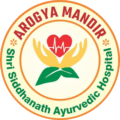Spondylosis and Disc Diseases

Introduction
Spondylosis, a term that might sound daunting, refers to the degeneration of the spine, particularly the discs and facet joints. It’s a common condition that affects people as they age, leading to discomfort and reduced mobility. In the world of Ayurveda, the ancient Indian system of medicine, Spondylosis is perceived through a holistic lens, considering the interconnectedness of the body, mind, and spirit.
Spondylosis is a broad term used to describe degenerative changes in the spine, particularly in the vertebrae and intervertebral discs. As the spine undergoes degenerative changes, various structures may be affected, leading to symptoms such as pain, stiffness, and reduced flexibility.
Key Aspects of Spondylosis Includes:
Osteoarthritis of the Spine: Spondylosis is often associated with osteoarthritis, a condition characterized by the breakdown of cartilage in the joints. In the spine, this can occur in the facet joints, which are the small joints between vertebrae.
Degeneration of Intervertebral Discs: The discs between the vertebrae act as shock absorbers and provide flexibility to the spine. With age, these discs can lose water content and become less resilient, leading to reduced disc height and potential narrowing of the spaces between vertebrae.
Bone Spurs (Osteophytes): As a response to the degeneration and loss of cartilage, the body may form bony outgrowths called osteophytes. These can contribute to joint stiffness and may cause compression of nearby nerves.
Stiffness and Pain: Spondylosis can result in stiffness of the spine, especially in the morning or after periods of inactivity. Pain is a common symptom, and it can vary from mild discomfort to more severe and chronic pain.
Reduced Range of Motion: The degenerative changes in the spine can lead to a decreased range of motion, making it challenging for individuals to bend or twist their spine comfortably.
Ayurvedic Approach to Spondylosis
In Ayurveda, the human body is believed to be composed of three fundamental energies or doshas: Vata, Pitta, and Kapha. Spondylosis is often attributed to an imbalance in these doshas, with Vata playing a significant role. In Ayurveda, Spondylosis is known as Sandhi Bhagna. And disc degeneration comes under Asthi Majja Kshaya.
A. Causes of Spondylosis in Ayurveda
According to Ayurveda, Spondylosis is a result of dosha imbalances aggravated by various factors. Sedentary lifestyle, improper diet, and aging are considered key contributors. Here are some common causes of Spondylosis
- Excessive Straining and Lifting weights
- Travelling on uneven road
- Excessive work
- Continous seating in bad posture
- Sleeping on uneven surface
- Continuous bending forward
Understanding these causative factors helps in tailoring Ayurvedic interventions for individuals suffering from Spondylosis.
B. Symptoms
1. Prodromal Signs:
- Morning stiffness
- Lower back pain
- Stiffness during work or sleep
2. Signs and Symptoms:
- Continuous low back pain
- Stiffness in the affected area
- Pain reduction after rest
- Relief with a hot water bath
C. Ayurvedic Diagnosis of Spondylosis
Ayurvedic practitioners use traditional methods such as Nadi Pariksha (pulse diagnosis) to assess the state of doshas and identify imbalances. Through a thorough examination, the specific dosha imbalance causing Spondylosis can be pinpointed, leading to personalized treatment plans.
Ayurvedic Treatments for Spondylosis
A. Ayurvedic Medicines:
Ayurvedic medicines for spondylosis focus on addressing the underlying imbalances in the body. Some commonly used Ayurvedic medicines for spondylosis include:
- Mahayograj Guggulu: This herbal formulation is known for its anti-inflammatory properties and is often used to alleviate joint pain associated with spondylosis.
- Ashwagandha (Withania somnifera): Ashwagandha is an adaptogenic herb that helps in managing stress, reducing inflammation, and promoting overall joint health.
- Guggulu: Guggulu resin is used in various Ayurvedic formulations for its anti-inflammatory and analgesic effects, making it beneficial for spondylosis.
- Shallaki (Boswellia serrata): This herb has anti-inflammatory properties and is known to support joint health, making it useful in managing spondylosis symptoms.
- Dashamoola Rasayana: A blend of ten herbs, Dashamoola Rasayana is used for its rejuvenating properties and is beneficial in managing pain and inflammation associated with spondylosis.
B. Ayurvedic Therapies:
- Abhyanga (Oil Massage): Abhyanga involves massaging the affected areas with medicated oils, promoting circulation, reducing stiffness, and providing relief from pain associated with spondylosis.
- Greeva Basti: This therapy involves creating a dam-like structure on the neck using dough and then filling it with warm medicated oil. It helps alleviate pain, reduce inflammation, and improve flexibility in the cervical spine.
- Kati Basti: Kati Basti is a therapy that involves retaining warm medicated oil in a well created on the lower back. It helps in reducing pain, stiffness, and inflammation associated with lumbar spondylosis.
- Asthivisthapan – Special pressure therapy used to correct displaced disc or vertebrae.
- Patra Pinda Sweda: In this therapy, warm poultices containing herbal leaves are applied to the affected areas. It helps in reducing pain, inflammation, and promoting relaxation of muscles.
- Panchakarma: Panchakarma therapies such as Virechana (therapeutic purgation) and Basti (medicated enema) may be recommended to detoxify the body and balance the doshas, particularly Vata, which is often aggravated in spondylosis.
- Nasya Therapy: Nasya involves the administration of medicated oils or herbal preparations through the nasal passages. It helps in reducing pain, congestion, and inflammation in the head and neck region.
- Lepa (Herbal Paste Application): Application of herbal pastes with anti-inflammatory properties to the affected areas can provide relief from pain and inflammation associated with spondylosis.
Diet, Yoga and Lifestyle Recommendations
A. Dietary Guideline
Diet plays a significant role in managing spondylosis by supporting overall health and reducing inflammation. Here are some dietary guidelines for individuals with spondylosis:
- Anti-Inflammatory Foods: Include foods with anti-inflammatory properties in your diet, such as fatty fish (salmon, mackerel), turmeric, ginger, garlic, and green leafy vegetables. These can help reduce inflammation in the joints.
- Omega-3 Fatty Acids: Foods rich in omega-3 fatty acids, such as flaxseeds, chia seeds, walnuts, and fish oil supplements, can help manage inflammation and support joint health.
- Calcium-Rich Foods: Consume foods high in calcium, such as dairy products, leafy greens, fortified plant-based milk, and nuts. Calcium is essential for maintaining strong bones and preventing further degeneration.
- Vitamin D Sources: Ensure an adequate intake of vitamin D through foods like fatty fish, fortified cereals, dairy, and exposure to sunlight. Vitamin D is crucial for calcium absorption and bone health.
- Whole Grains: Choose whole grains like brown rice, quinoa, and whole wheat over refined grains. Whole grains provide essential nutrients and fiber, supporting overall health.
- Protein Sources: Opt for lean protein sources like poultry, fish, tofu, legumes, and nuts. Protein is essential for muscle health and overall body function.
- Hydration: Stay well-hydrated by drinking plenty of water throughout the day. Proper hydration supports joint function and helps maintain the elasticity of spinal discs.
- Limit Inflammatory Foods: Reduce the consumption of processed foods, sugary snacks, and beverages, as they can contribute to inflammation. Also, limit the intake of red meat and high-fat dairy products.
- Spices: Incorporate anti-inflammatory spices like turmeric, ginger, and cinnamon into your meals for added flavor and potential health benefits.
- Maintain a Healthy Weight: Strive to maintain a healthy weight through a balanced diet and regular exercise. Excess weight can contribute to increased stress on the spine.
B. Lifestyle Recommendation:
- Regular Exercise: Engage in regular, low-impact exercises that strengthen the core muscles, improve flexibility, and support the spine. Activities like swimming, walking, and gentle yoga can be beneficial.
- Correct Posture: Maintain proper posture while sitting, standing, and lifting objects. Use ergonomic furniture and accessories to support good posture and reduce strain on the spine.
- Avoid Prolonged Sitting: Take breaks from prolonged sitting and incorporate movement into your routine. Stand, stretch, and change positions regularly, especially if you have a desk job.
- Weight Management: Maintain a healthy weight to reduce stress on the spine. Adopt a balanced diet and engage in regular physical activity to achieve and maintain a healthy weight.
- Quit Smoking: Smoking can contribute to degeneration of spinal discs. Quitting smoking not only benefits overall health but also supports spinal health.
- Proper Mattress and Pillow: Choose a supportive mattress and pillows that help maintain the natural curvature of the spine. This can contribute to a better night’s sleep and reduce strain on the neck and back.
- Stress Management: Practice stress-reducing techniques such as meditation, deep breathing exercises, or mindfulness. Chronic stress can exacerbate symptoms of spondylosis.
- Avoid Heavy Lifting: Minimize heavy lifting, and when lifting objects, use proper lifting techniques. Bend at the knees and lift with your legs, not your back.
- Heat and Cold Therapy: Use heat or cold packs to manage pain and inflammation. Applying heat can help relax muscles, while cold therapy may reduce inflammation.
- Footwear: Choose comfortable, supportive footwear that provides stability. Avoid high heels and shoes with inadequate arch support.
C. Yoga and Pranayama:
Yoga and pranayama, when practiced mindfully, can offer significant benefits for individuals dealing with spondylosis. Here are some yoga postures (asanas) and breathing exercises (pranayama) that may help alleviate symptoms and improve spinal health:
Yoga Asanas:
- MarjariasanaThis gentle flow between arching and rounding the back helps improve flexibility and mobility of the spine.
- Balasana: This resting pose stretches and relaxes the spine, promoting relief from tension.
- Adho Mukha Svanasana: This pose stretches the entire spine, shoulders, and hamstrings, fostering flexibility.
- Bhujangasana: Strengthens the back muscles and promotes flexibility in the spine.
- Setu Bandhasana: This asana targets the spine, hips, and thighs, strengthening the back and reducing stiffness.
- Paschimottanasana: Stretches the spine and hamstrings, providing relief from tightness.
- Trikonasana: Strengthens the back and leg muscles, enhancing overall stability.
Pranayama Techniques:
- Pranayama: Focus on deep diaphragmatic breathing to increase oxygen flow, reduce stress, and promote relaxation.
- Nadi Shodhana: Balances the nervous system, helping alleviate stress and tension.
- Kapalabhati: Invigorates the nervous system and promotes mental clarity.
- Bhramari: Calms the mind, reduces stress, and can alleviate headaches associated with spondylosis.
- Ujjayi Pranayama: Enhances concentration, reduces tension, and promotes relaxation.
FAQs
Ayurveda’s effectiveness in managing Spondylosis is supported by traditional knowledge and emerging scientific studies.
The timeline for improvement varies based on individual factors, adherence to treatments, and the severity of the condition.
When prescribed and administered by qualified Ayurvedic practitioners, remedies are generally safe for long-term use.
Adopting Ayurvedic principles in daily life, including proper diet, exercise, and stress management, can contribute to preventing Spondylosis.
Uniqueness of our therapies
At Arogya Mandir – Shri Siddhanath Ayurvedic Hospital, Miraj, we delve deeply into the ayurvedic examination of each patient. Utilizing noninvasive Ayurvedic diagnostic tools such as Ashtavidha Parikshan and Nadi Parikshan, we precisely determine the pathogenesis of the disease and then prescribe therapies tailored to the specific condition. This approach leads to expedited results.
Our therapies boast the following distinctive features:
– Tranquil and hygienic therapy rooms staffed with trained therapists in a positive environment.
– Selection of appropriate massage oil based on the patient’s Prakruti and the condition of the disease.
– Complimentary Prakruti and Dhatu Sarata examinations before the commencement of therapies.
– Authenticated procedures for each therapy.
– Judicious use of herbal medicines and instruments during the therapy sessions.
– Specialized rooms equipped with all facilities for inpatient care.
Feel free to share this article at no cost.
Copyright message – Dr. Prashant Chivate has published this article on drchivateayurved.org for informational purposes about diseases. Any other use of this article is strictly prohibited. All rights reserved.
